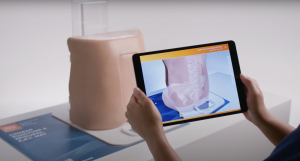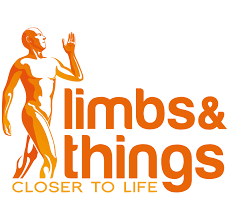Limbs & Things, the Bristol-based medical simulator company, has harnessed the power of augmented reality (AR) for its latest training device in a move it hopes will revolutionise the way nursing students learn.
Its ART (Augmented Reality Training) product works with everyday tablets and smartphones to show a 3D, 360-degree interactive view of internal anatomy.
By physically moving around a simulation manikin, trainees can see a procedure from all angles before practising techniques such as lumbar punctures and catheterisations.
They will even be able to practice on their own phones away from the training centre.
The in-house team at St Philips-based Limbs & Things designed the affordable mat for worldwide use, but particularly to help improve medical training in developing countries like India who may not have access to some of the high-end training tools.
Unlike expensive VR headsets, the ART mat is very cost effective – it is automatically included in the purchase of a range of Limbs products and can be bought for just £250 to retrofit onto a previously bought task trainer. and can be used with a range of Limbs products.
It is particularly useful for essential techniques such as lumbar punctures, catheterisation, and epidurals because it shows the medical professional what is happening inside the body at the same time as they are carrying out the intricate procedure.
Lumbar punctures, in particular, are notoriously difficult and highly pressured procedures as they involve inserting a needle through a 10mm or less gap in the spinal cord..
Practising these procedures with the ART mat helps trainees become more confident performing examinations, which in turn improves the patient’s experience.
The prototype has been developed in collaboration with the Royal College of Obstetricians and will be applied initially to two Limbs & Things products – catheterisation and lumber puncture & epidural, which cover a wide range of skills from undergraduate to highly specialist.
The firm also aims to apply the mat to its chest drain and PROMPT flex products and eventually apply AR to a range of its products.
Limbs & Things commercial director Anne Allin said: “We wanted first and foremost to improve the training experience for some of the more invasive procedures, as well as standard diagnostic processes, that need to be carried out on a patient, but we also wanted it to be within reach cost-wise for as many teaching institutions as possible around the world.
“It’s very important to us as a business that our products are accessible, both from a practical and pricing point of view – ultimately we want to improve all patient outcomes through better training, not just some.”
“This product is particularly exciting because it is using technology in a very simple yet highly effective way and takes training on our simulators to yet another level.”
More than 67,000 diagnostic and nearly 15,000 therapeutic lumbar punctures are performed in England each year.
Lumbar puncture is commonly performed as part of a septic screen in infants under three months of age. The success rate is highly variable, between 50–70%, and many infants require multiple attempts.
Limbs & Things was founded in 1990 by medical illustrator Margot Cooper and now employs 230 people producing a range of medical simulators.
While its products are lifesize models of parts of the human body, the firm is moving into the use of technology to add value to the training experience.
Earlier this year it acquired eoSurgical, a market leader in the use of technology and self-directed learning in laparoscopic surgery.
Its simulators are entirely portable and the instrument-tracking software and on-line training portfolio is optimised for smartphones and tablets, allowing training to take place in dedicated simulation environments, in operating theatres or even at home.






























